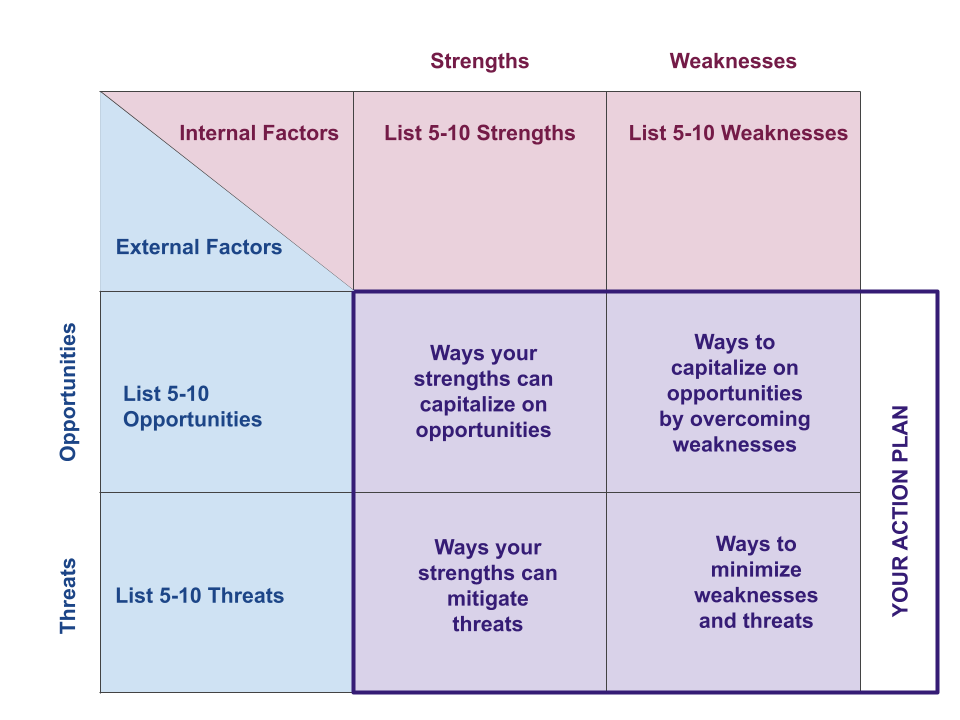Recent history has showed us how quickly norms can be upended and the waves of change can hit. Nonprofits, like other social and physical structures, need to build resiliency for the future. When conducted correctly, SWOT analysis can be a great tool for creating a nonprofit’s contingency plan and growing its adaptability.
Many organizations fail to benefit from a SWOT analysis because it has been widely mistaught, and they are only partially completing the exercise. Here we share how to conduct a SWOT analysis so that it generates real results for your organization.
What is SWOT Analysis?
If you’re unfamiliar with it, SWOT stands for strengths, weaknesses, opportunities, and threats. It is an important tool for strategic management in the nonprofit and public, as well as private, spheres. By embracing strengths, acknowledging weaknesses, and appreciating external threats and opportunities, SWOT analysis helps organizations to protect their core values and plan for the future.
Differences Between SWOT Analysis for Businesses and Nonprofits
Unlike the strengths of businesses, which usually focus on what a company does better than its competitors, nonprofits should focus on their relative strengths compared to similar organizations or to an ideal.
Despite these differences, many SWOT lists for nonprofits will look similar to lists for businesses. Both sectors may also be targeting the same audience, which means that you should consider comparing yourself to businesses as well as you conduct your analysis.
Applications of SWOT Analysis for Nonprofits
A SWOT analysis is one of the basic planning and evaluation tools for nonprofit organizations. Nonprofits can use this tool for marketing, strategic planning, needs analysis, program development, and much more. However, nonprofit organizations must focus their analysis on specific functions to best benefit from the process.
Here is a breakdown of ways to use SWOT analysis within your organization.
Marketing Strategy
Nonprofits require marketing to attract new donors, showcase success, gain media attention and boost their reach. Therefore, it’s important to craft a strategy that utilizes existing resources for maximum return.
While developing a marketing strategy, SWOT analysis can discover important information about staffing, budget, and potential partners or donors. If qualified and competent staff is one of the organization’s strengths, the directors can build a strategy around that and make the team a featured component in marketing campaigns.
Improving Programs
Nonprofits can use SWOT analysis to address many program issues, including lack of best practices, funding, publicity, or even social acceptance for its programming. For clear examples of the many ways in which SWOT can be applied for strategic decision-making at your nonprofit, as well as examples of how and how not to list specific SWOTs, take a look at this webinar from Clare Axelrod and Boomerang.
The webinar also covers how to use SWOT analysis to develop your board, plan annual fundraising, improve organizational culture, and more.
Website Redesign
Conducting a SWOT analysis before a website project can uncover issues like your organization’s lack of visibility or technology skill gaps in your staff.
It can also help you to assign budget priorities: you should emphasize an SEO audit over additional custom templates if your organization is struggling to attract new supporters.
How to Do A SWOT Analysis for Your Nonprofit
SWOT analysis involves a dual approach: an internal focus on strengths and weaknesses and an external focus on opportunities and threats.
Strengths
Strengths are anything that your organization does well. As mentioned earlier, your nonprofit may also be comparing itself to businesses that seek to engage the same audience. Examples of organizational strengths can include:
- The staff is experienced
-
The organization has a clear mission and passionate volunteers
- The government takes care of a large percentage of the operating costs
- There are two (or more) major donors
- The leadership has an excellent reputation and strong links in the community
- The organization has a well-maintained website that attracts new visitors/donors
Most nonprofits are also exempt from taxes, which is another strength. Listing even the mundane or obvious strengths can make it easier to identify new opportunities as you continue through the exercise.
Weaknesses
The weakness quadrant allows you to list things you consider deficient at your nonprofit. Here you can include anything that causes internal problems for your organization. Examples of common weaknesses include:
- Lack of financial stability, which is most common among nonprofits that are still in their early years
- Small staff who have skill gaps
- Poor or little reputation in the government
- Lack of equipment/facilities
- Reliance on a small pool of donors
- Poor intake process
Weaknesses should only come from your internal issues; external factors will be addressed under threats.
Opportunities
Opportunities are external factors which have potential to benefit the organization. Consider everything that could be helpful in the future. Here are some examples of opportunities:
- The government is increasing funding or considering legislation related to your nonprofit
- Other NGOs in your area would like to partner
- Shrinking or closure of nearby organizations could grow your client and supporter base
It’s a good idea to spend some time researching legislation and general trends in order to complete a thorough and thoughtful list of opportunities.
Threats
Threats are the external factors that the organization cannot control, but they may cause negative/adverse effects to the organization now or in the future. Examples of threats that you can list for your nonprofit include:
- Your primary source of funds reports a possible budget deficit in the next three years
- The program costs have been increasing for the past few years due to factors beyond your control
- Political factors are a threat to your organization
- There is an effort to discredit your organization or research from within your sector as a whole
- New compliance requirements are passed, such as recent laws affecting donor data privacy
Note that every organization faces unique threats. Take your time to analyze the critical issues facing your organization and to complete all the SWOT quadrants.
Turn Your Analysis into Action
Your SWOT analysis is not finished until you’ve created proper actionable follow-up. Together with your team, you should plan on how to:
- Increase your opportunities using your nonprofit’s strengths
- Use strengths to reduce your threats
- Eliminate weaknesses by taking advantage of opportunities
- Reduce weaknesses to mitigate potential threats
Here’s how to set up a SWOT matrix for actionable take-aways:
An effective SWOT analysis matches strengths and weaknesses to corresponding opportunities and threats. The goal is to leverage the positives for growth and mitigate negatives to minimize potential risk.
Strategic Pairing
Ideally, an organization utilizes strengths to take advantage of available opportunities. After completing all four quadrants, begin pairing strengths to opportunities.
As an example, if one of your strengths is that you have an experienced grant writer in your team, you could pair that with looking for more federal grant opportunities.
Operationalize The Opportunity
After identifying your strategic pairings, hold a meeting to operationalize them. If there are many to address, list them in order of priority. It’s advisable to prioritize items that bring financial growth through funding, more donors, and partnerships. You can subsequently prioritize organizational growth, operation efficiency, or achieving cultural change.
The last step involves creating a roadmap to achieve the objective that includes allocating resources and assigning one person to be responsible for shepherding the project into fruition.
Remember, a true SWOT analysis pairs each positive attribute to a negative attribute that it can address. Don’t stop at merely identifying strengths, weaknesses, opportunities and threats. Complete all the steps outlined here to walk away with actionable outcomes for your nonprofit.




